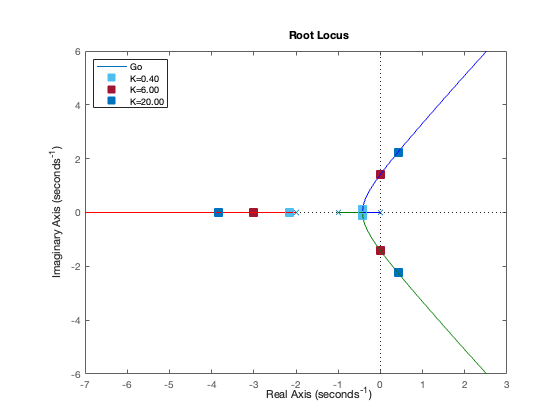Exercise 2.3#
Fig. 7 Closed-loop system#
Depicted above is the block diagram of a closed-loop system.
For what values of the controller parameter \(K\) is the closed-loop stable?
Is there any value of \(K\) such that the closed-loop can track the reference signal \(r(t) = 0.1 \textrm{ramp}(t)\) with an error less than \(5 \cdot 10^{-3}\)?
Solution#
Question 1#
The open-loop transfer function of the system is
The closed-loop transfer function is
Unfortunately, \(G_c(s)\) is a third-order transfer function, therefore we cannot analytically inspect how the poles of \(G_c(s)\) change as a function of \(K\).
Two approaches can be used to solve the exercise:
Using the Routh stability criterion
Using the rootlocus
Because the former is out of the scope of this course, we will go for the second one. Let’s plot the root locus of \(G_o(s)\)
s = tf('s');
Go = 1/(s*(s+1)*(s+2));
rlocus(Go); hold on; % Plot the root locus
% Plot the closed-loop poles for specific values of K
K_points = [0.4, 6, 20];
for k=K_points
Gok = k * Go;
[num, den] = tfdata(Gok, "vector");
poles = roots(num + den);
p = plot(real(poles), imag(poles), 's', 'MarkerSize', 10, 'MarkerFaceColor', 'auto', 'DisplayName', sprintf('K=%.2f', k));
set(p, 'markerfacecolor', get(p, 'color'));
end
legend('Location', 'northwest'); hold off;

Note that:
For \(0 < K \leq 0.4\), the closed-loop are real-valued and negative
For \(0.4 < K < 6\) we have 1 real-valued negative pole and two complex-conjugate (dominating) poles with negative real part.
For \(K >6\) the two complex-conjugate poles have positive real part, so the closed-loop is unstable.
The solution is therefore \(0 < K < 6\).
Question 2#
Under the assumption that the closed-loop is stable (\(0 < K < 6\)), we can apply the Final Value Theorem, where the reference is \(R(s) = \frac{0.1}{s^2}\).
Recalling that Laplace transform of the error is \(E(s) = R(s) - Y(s) = (1 - G_c(s)) R(s)\),
To get the desired error, we impose
Unfortunately, this error is not achievable because for \(K > 6\) the closed-loop is unstable.
